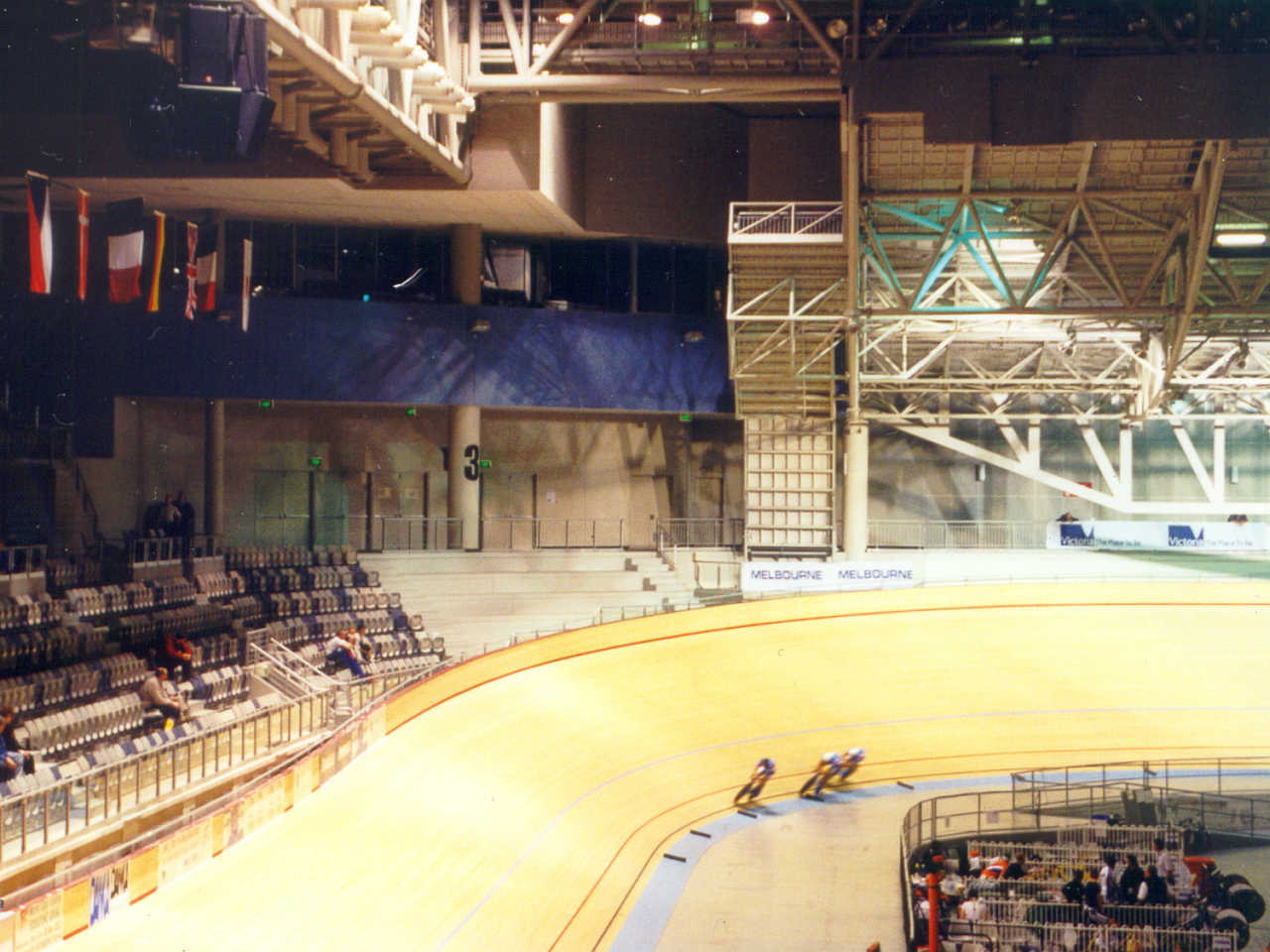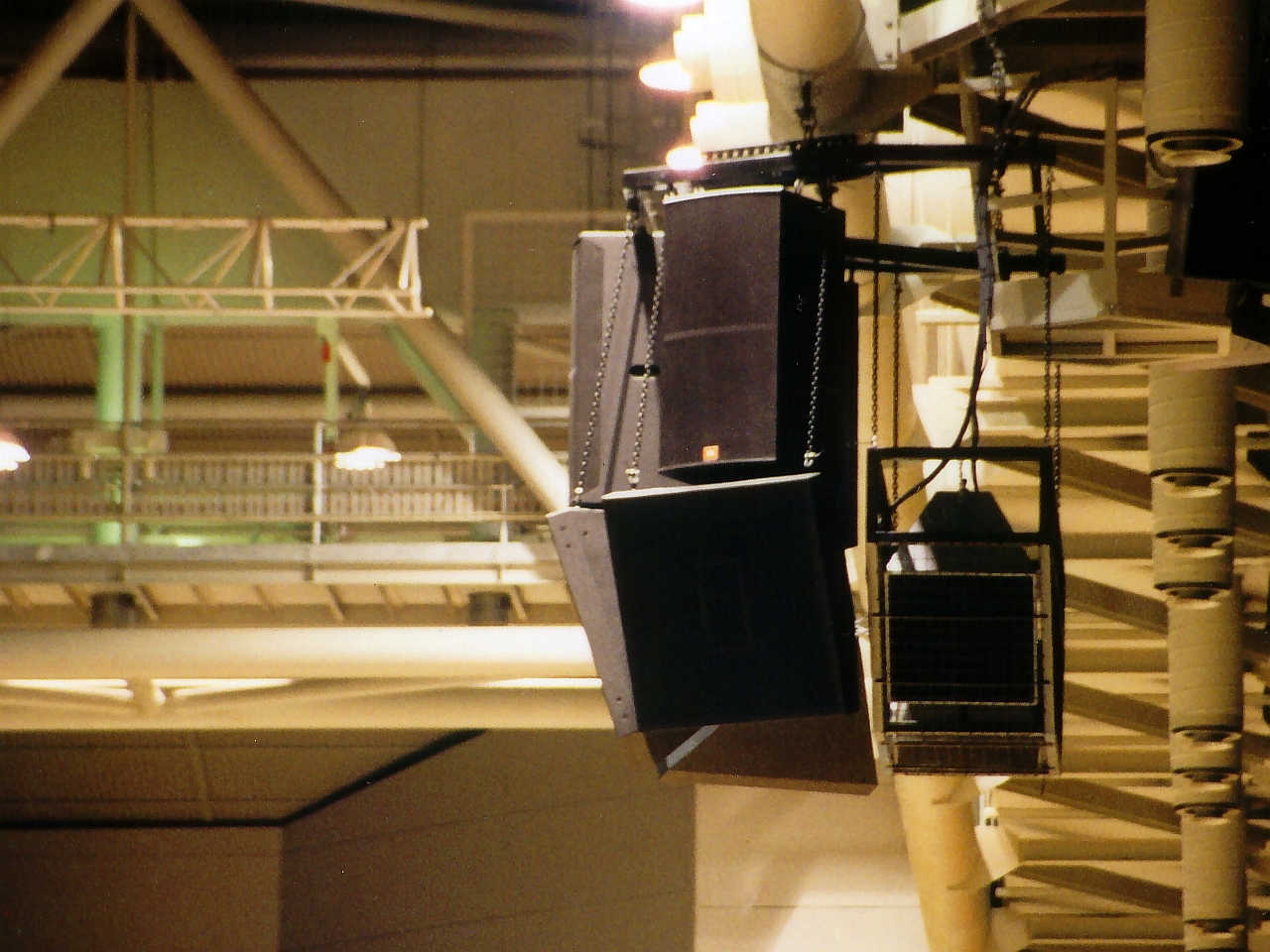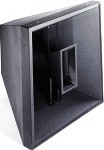JBL PD Loudspeakers installed in Australia

The Vodafone Arena is the newest addition to Melbourne, Australia's premier sports and entertainment precinct.
A purpose-built multi-function stadium, the venue has a maximum capacity of 10,800 retractable and removable seats which enable the venue to be transformed from one event configuration to another, including tennis, basketball, live music concerts and velodrome.
The 250 metre velodrome circuit is designed and constructed by world renowned builder, Ron Webb to produce fast times and exciting racing.
A retractable roof which takes only ten minutes to fully open or close allows the venue to be transformed from an indoor arena to an outdoor venue.
The roof presents a challenge to the sound designer, because the loudspeaker system cannot be mounted in the center of the arena. The closest fixed suspension points are on the catwalk which runs around the perimeter of the open roof structure.
The original sound system, comprising a six-element circular array 15" 2-way loudspeakers delivered acceptable audio level to the seating banks immediately behind the cluster, a projection distance of 10-20 metres, but was not capable of generating sufficient loudness to be intelligible in seating areas at the other three sides of the stadium, which vary in distance from 30 to 85 metres.
Local A/V contractor and JBL dealer, Warehouse Sound Systems who had in previous years supplied a JBL central cluster rental system to an adjacent venue for use by the local pro-basketball competition, was approached to recommend an upgrade to the loudspeaker system, utilising existing loudspeakers, amplifiers and processing equipment.
Sven Langebeck, owner and chief engineer at Warehouse Sound Systems, together with Douglas Growcott from Watson Moss Growcott, acoustic consultants, examined various combinations of new and existing equipment and budgets that would meet or exceed specifications.
A number of scenarios were presented to the venue owners. It was fortuitous that JBL had recently released their new PD stadium horn loudspeakers, yet to be seen or heard in Australia, whose published performance ratings suggested one of the most powerful loudspeakers ever manufactured. On the strength of argument in JBL's published White Paper and Engineering Data these became the favoured option of the design team.
Once the design specification was accepted, the project went to competitive tender, and Warehouse Sound Systems became the successful bidder.
JBL manufactured and air-freighted the loudspeakers in record time, while the cluster frame was pre-manufactured to precise specifications.
The loudspeakers together with rigging frame and cables were installed within three days of arrival, two weeks ahead of schedule. With great anticipation the system was tuned and commissioned over the following quiet weekend.
It is fair to say the completed system exceeds expectations. In the worst case situtation, when the arena is empty, voice announcements are clearly intelligible from every seat in the house, so much so that verification by Alcons and RASTI measurements were not deemed necessary. Voice announcements at the furthest distances measure 96db, exceeding the minimum spec with comfortable headroom.
"We chose the PD speaker system based on the specifications publicised by JBL and, from the arguments put forward in a white paper describing the technology used." said Sven Langebeck. "My confidence in the accuracy of JBL specifications has been built up over many years," continued Sven "again they did not let me down - the commissioned system, when fired up exceeded all the expectations of the design team."

Contact Details:
Melbourne and Olympic Parks
Batman Avenue Melbourne
GPO Box 4611SS Melbourne 3001
Phone: +61 3 9286 1600
Facsimile: +61 3 9650 3256
Email: enquiries@mopt.vic.gov.au
Web: www.melbournepark.com.au
Vodafone Arena Audio System
Abstract
Sporting arenas are highly reverberant environments, presenting a challenge to any audio designer. Concrete floors, plaster walls and plastic seating all contribute to a long reverberant decay times and multiple short reflections which degrade intelligibility.
Multiple short delays caused by path-length differences are particularly troublesome. For example, if a listener is 20 meters from one sound source and ten meters from another, the delay between the two signals would be in the order of 35 milliseconds yet there will only be a 6dB difference in intensity between the two signals. Such a delay is clearly audible to the listener, and when multiplied many times throughout the venue causes severe degradation of articulation.
This phenomena often occurs when multiple loudspeaker systems overlap such as found in some outdoor venues, and/or when sound reflects from a large planar surface, such as the back or side walls of an arena or grandstand.
Distributed Systems
The most effective means to achieve maximum articulation in highly reverberant areas involves multiple distributed clusters of loudspeakers, each servicing a dedicated section of the audience with minimal overlap with adjacent loudspeakers.
Each element of a distributed cluster would be activated only when that section of seating is occupied. The downside to this approach is the additional cost presented by large numbers of drivers, amplifiers and cable required to provide sufficient coverage.
An excellent implementation of this approach can be found at the Colonial Stadium in Melbourne, where Sydney contractor, PA People installed multiple clusters of JBL horn loaded cabinets, together with under-balcony fills to produce seamless coverage to every seat in the house.
Single Cluster Systems
A single cluster of loudspeakers arranged in a hemispherical or semi-circular array, provides a near "point source" of sound, virtually eliminating multi-path delays between adjacent loudspeakers.
A single cluster system is prone to short delay reflections from walls and seating tiers which arrive at a listeners ears in conflict with the direct sound. Before implementing a central cluster design, careful attention needs to be taken of potential delays due to multi-path reflections.
Central cluster systems need to produce considerable peak sound pressure levels, because of the relatively longer distances to be covered. To achieve 100dB at distance of 80 meters requires 138dB to be produced at the horn mouth. Furthermore, high frequencies above 5kHz are further reduced due to air absorption. There are very few driver/horn combinations which can produce such extreme sound pressure levels from a single cabinet. The JBL PD764 is one of them.
Description of Arena
The floor plan of the arena forms a square approximately 100 meters x 100 meters with tiered seating on four sides of a center court. A retractable roof extends to within 20 metres of the stadium walls on all four sides.
The most centrally located position for a loudspeaker cluster is therefore 20 metres from one wall and eighty metres from the opposite wall. From this location the majority of seats are within 40 meters of the cluster location.
The arena converts to velodrome mode by raising two entire seating areas on opposite sides of the center court, exposing the cycle track underneath.
The walls exposed by the raising of the seats, and the underside of the seats themselves are treated with sound absorbent panels to reduce reflections.
The result in velodrome mode is a remarkable short reverb time with minimal flutter echoes, which increase marginally when the seats are down. A number of seating locations are identified as suffering from multi-path delays in the 30-50 milliseciond range, however they represent significantly less than 10% of the total seated areas at any time.
Purpose of Audio System
The audio system shall reproduce voice announcements, running commentary and background music for sporting events such as basketball, tennis and cycling. Voice announcements shall be clearly audible and intelligible in every seat of the house above the noise of enthusiastic spectators.
Sound pressure level shall meet or exceed 90dB(A) SPL when measured over 90% of the seated area.
Determining Factors
The decision to upgrade the existing central loudspeaker with the addition of JBL PD long-throw loudspeakers was determined after due consideration of the following factors.
- The reverberation and short-delay characteristics of the venue were considered acceptable for a central cluster design
- Only one half of the previous cluster required upgrade, the rearward facing loudspeakers performing to specification for their intended coverage pattern
- The loudspeakers proposed to be replaced could be redeployed to serve the seating areas below the cluster, which previously had no coverage
- The new JBL PD series stadium horns makes available a single, coaxial loudspeaker cabinet, rated to produce 104dB continuous at 50 meters in the critical 250-1500Hz "vocal" frequency range, which in this case exceeds the required SPL target of 90dB(A) at the furthermost seats in the house.
Specifications
The arena audio system is intended to serve as public address and commentary during sporting events, in which the vocal range from 250Hz - 2kHz will be the primary source.
The system comprises a single cluster of loudspeakers suspended from one side of the retractable roof opening, powered by 7,500 watts of amplification which disperses in a hemispherical pattern over the entire arena.
Due to its off-center location, one half of the loudspeaker cluster is required to project audio to seated areas 40m to 80m distance from the cluster, whilst the projection distance underneath and behind the cluster varies from 10 meters to 40 meters.
The specifications call for 90db(A) ±3db SPL when measured over 90% of the stadium.
Frequency response variations shall not exceed ±6db beteewn 125Hz and 12kHz when measured over 90% of the stadium area when stadium is half full and roof closed.
Arrangement
 The loudspeaker cluster directs sound to all seats in the stadium from a central point, utilising the following components:
The loudspeaker cluster directs sound to all seats in the stadium from a central point, utilising the following components:
Three JBL VS125HS horn-loaded bass loudspeakers are arranged in 3-wide arc at the top of the cluster to provide low frequency reproduction below 250Hz.
Three JBL PD764 long-throw loudspeakers are arrayed underneath the bass loudspeakers, facing the seating tiers on three sides of the arena forming an even 180° x 40° coverage pattern in the mid and high frequency ranges. Each loudspeaker is tilted downwards at 18° to mimimise reflections from the upper walls and ceilings.
Three Peavey HV1582 15" 2-way loudspeakers, forming an 180° x 40° coverage angle, face the fourth seating tier behind the cluster.
Three underslung Peavey HV1582 15" 2-way loudspeakers provide 120° x 80° dispersion pattern directed towards the seating area in front of and underneath the cluster.
Components
3 x JBL PD764 Mid & HF Horn Loudspeaker
3 x JBL VS125HS 2 x 15" Low Frequency Horn Loudspeaker
5 x QSC RMX2450 2 x 750w/4 ohms Amplifier
1 x Peavey MediaMatrix® X-Frame™ Processing System
6 x Peavey HV1582 1 x 15" & HF Loudspeaker
4 x Australian Monitor PA1200 2 x 600w/4 ohms Amplifier
Computations from Manufacturers' Data
The following maximum and average SPL levels are calculated from manufacturer's published specifications and apply to a single cabinet. The calculated available amplifier power takes into consideration the combined load of loudspeakers and cable. High frequency response calculations allow for a modest reduction in long distance projection due to the effects of air-absorption caused by humidity.
| Sensitivity 1w@1m |
Available Power |
Peak SPL @1m |
Peak SPL @40m |
Peak SPL @80m |
Avg SPL @40m |
Avg SPL @80m |
|
| JBL PD764 HF Band centered at 2kHz |
109db | 231w | 133db | 98db | 91db | 92db | 85db |
| JBL PD764 Mid band centered at 500Hz |
106db | 430w | 132db | 100db | 94db | 94db | 88db |
| JBL VS125HS Bass centered at 125Hz |
104db | 325w | 129db | 97db | 91db | 91db | 85db |
Schematic


Professional PD764
Very High Output Mid-High Loudspeaker System
Excerpt from
JBL Engineering Data © Copyright 2000 JBL
Key Features:
- 60° by 40° Coverage Pattern symmetrical frontal dimensions allow horizontal or vertical orientation within an array
- IFS™ Interference Free Summation dual HF driver module eliminates destructive interference and increases output by 6dB
- Dual 8" horn loaded cone mid-frequency drivers provide 6dB greater output than traditional designs
- Pattern control maintained to below 400Hz
Co-axial mid/high-frequency module layout improves midfrequency arrayability and minimizes size. Integrated rigging system simplifies array design and construction. The PD764 Precision Directivity™ loudspeaker provides high-impact sound reinforcement at throw distances that are beyond the reach of single-driver designs. A single module produces greater than 104dB SPL (continuous) at distances of 50m (165ft).
The PD764 may be used in clusters with other PD family modules or singly as part of a distributed system. The PD764 transducer complement features JBL's most advanced technology.
The 2250J NDD™ Neodymium Differential Drive® 8" midrange transducer features a high energy neodymium magnet based motor, dual voice coils and a large aluminum heatsink structure.
The 2430H compression driver utilizes the latest in magnet and diaphragm technology to pack the performance of a traditional 10.5Kg (23lb), 25cm (10in) diameter compression driver into one weighing 1Kg (2.2lb) and measuring 10.8cm (4.25in) in diameter.
System Specifications:
Frequency Range (-10dB): 150Hz-17kHz
Frequency Response (±3dB): 200Hz-15kHz
Hor Coverage Angle (-6dB): 60°
Vert Coverage Angle (-6dB): 40°
Directivity Factor (Q): 20
Directivity Index (DI): 13dB
Recommended crossover frequencies:
225Hz, 1.5kHz
Nominal Impedance:
MF: 8 Ohms
HF: 16 Ohms
Input Power Rating:
Rating based on AES test signal of filtered random noise with a peak-to-average ratio of 6dB, two hours duration.
MF: 700W AES (2800W peak)
HF: 150W AES (600W peak)
Sensitivity:
Sensitivity is based on a swept test signal for an input of 1 Watt at rated impedance.
MF: 109dB, 1W @ 1m (3.3ft)
HF: 116dB, 1W @ 1m (3.3ft)
Calculated Maximum SPL:
MF: 137dB Continuous; 143dB Peak SPL @ 1m (3.3ft)
HF: 138dB Continuous; 144dB Peak SPL @ 1m (3.3ft)
Transducers:
Mid Frequency: 2 x 2250J - 203mm (8in) cone, Dual 75mm (3in) edgewound ribbon voicecoil, NDD™ motor structure
High Frequency: 2 x 2430H - 75mm (3in) diaphragm, 38mm (1.5in) aperture, neodymium magnet
Physical:
Enclosure: Dual Trapezoidal, 35° vertical, 55° horizontal; birch plywood
Suspension Attachment: M10 threaded points, 20 total; 5 each top & bottom, 4 each side, 2 rear
Finish: Black DuraFlex™ coating (white & custom colors optional)
Grille: Black powder coated zinc treated 14 gauge perforated steel with black foam backing (white & custom colors optional)
Input Connector: Neutrik NL4 SpeakOn (Options: barrier strip or captive cable)
Dimensions (HxWxD): 39in x 39in x 34.75in
991mm x 991mm 883mm
Net Weight: 215lb 97.7kg

JBL Professional 8500 Balboa Boulevard
PO Box 2200 Northridge
California 91329 USA
© Copyright 2000 JBL Professional
A Harman International Company